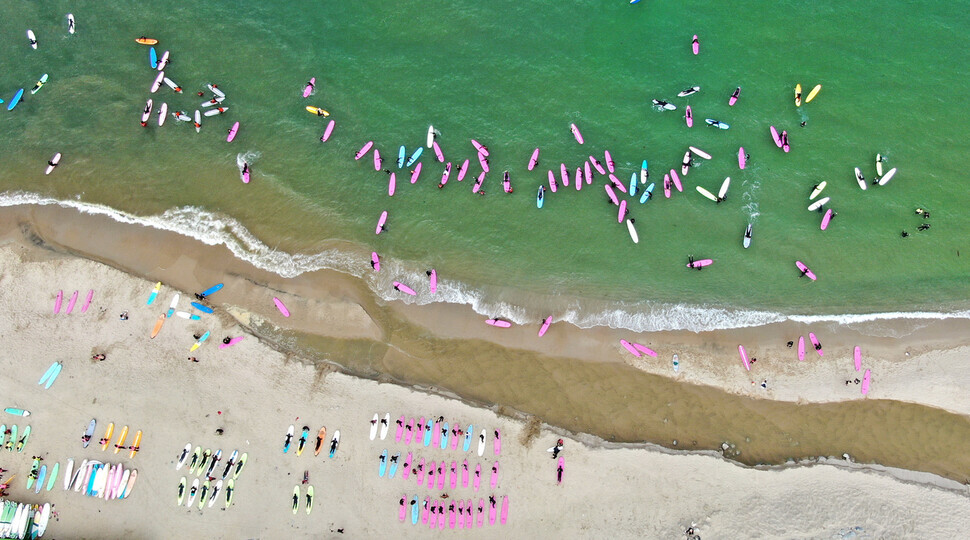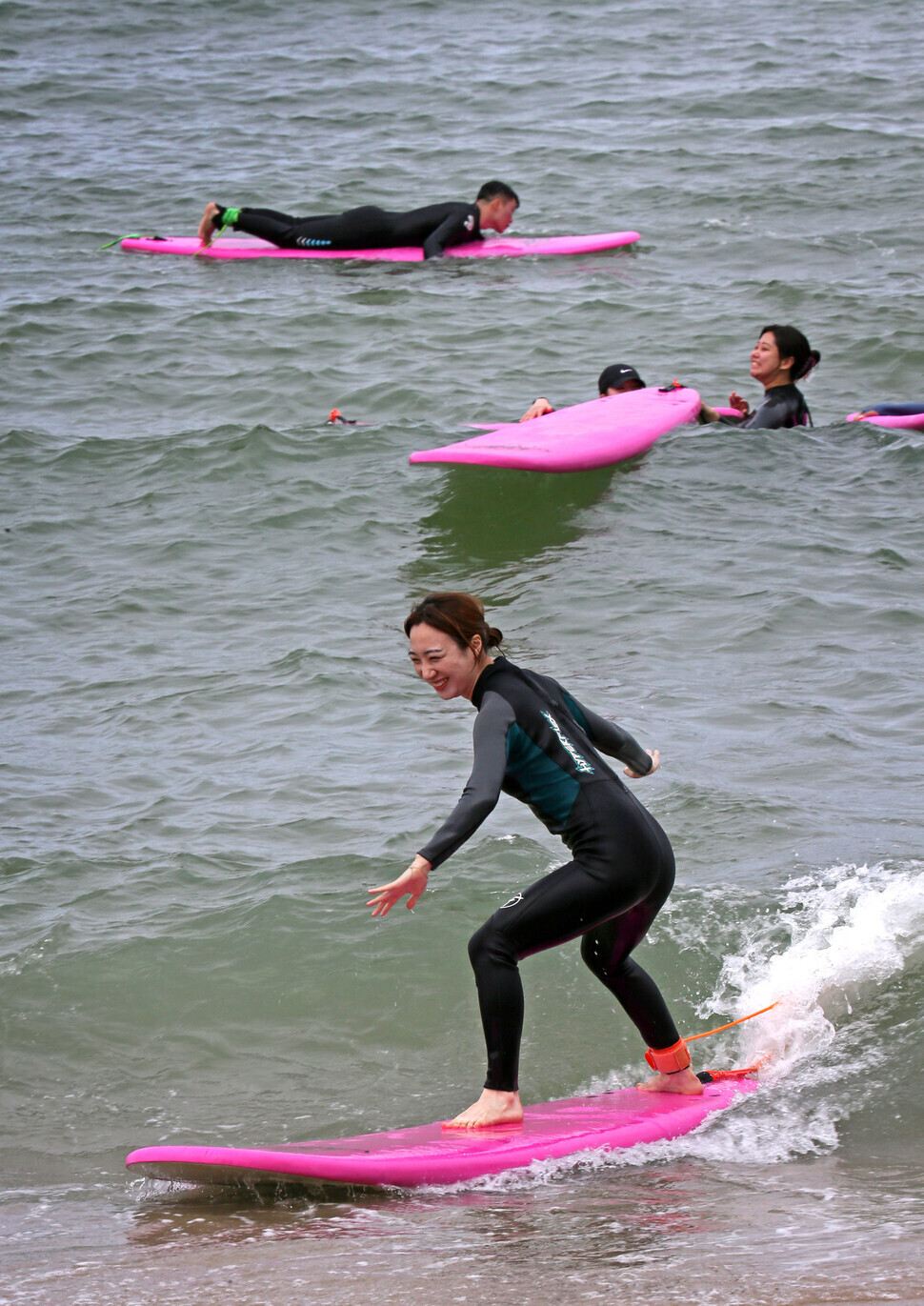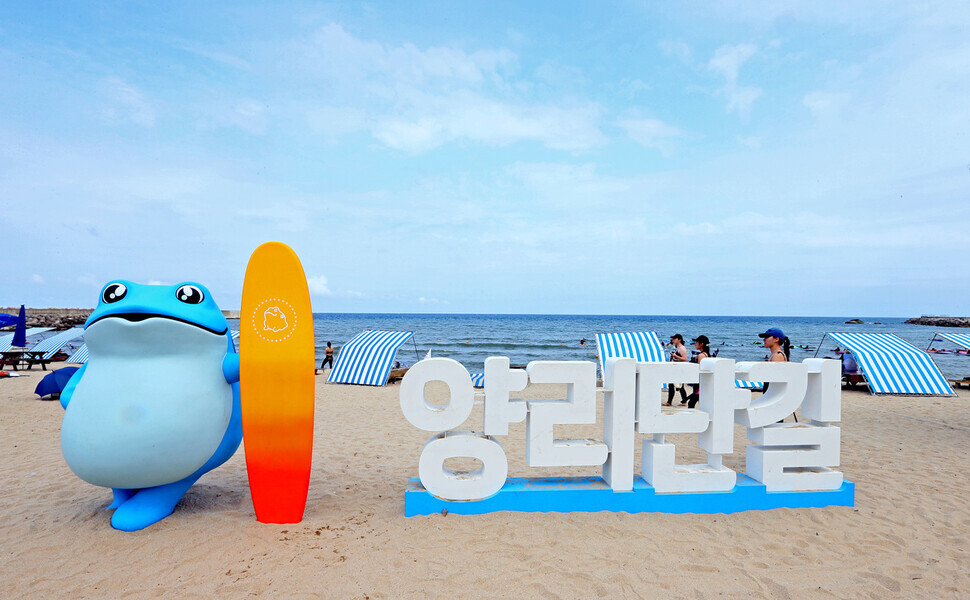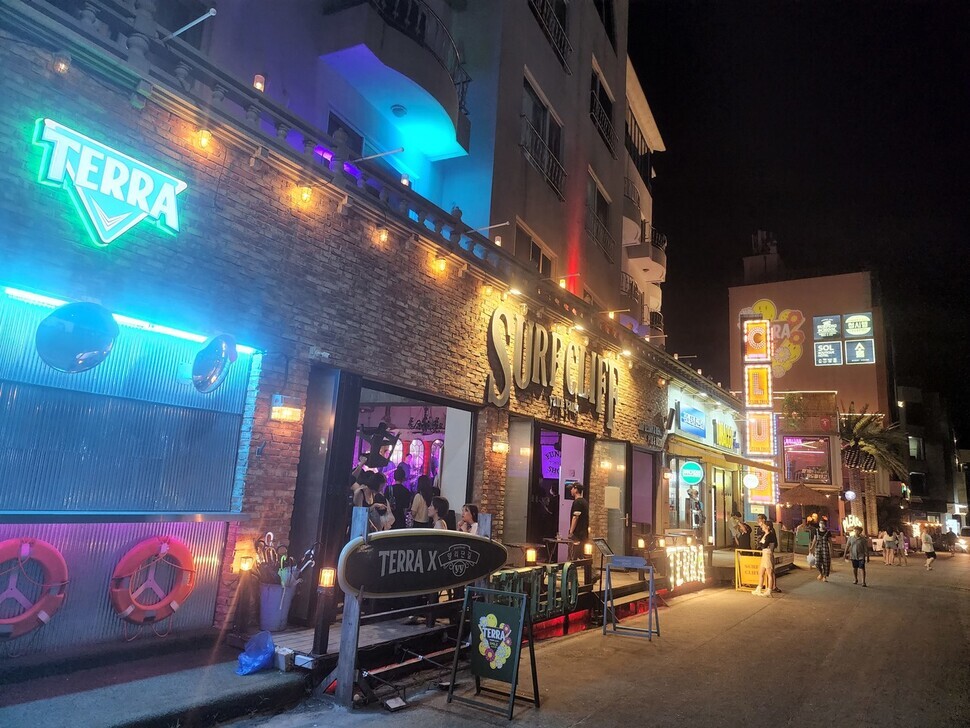hankyoreh
Links to other country sites 다른 나라 사이트 링크
[Korea travels] Catch some waves and hang loose in Yangyang, Korea’s surfing mecca

Is there any place hotter this summer?
On July 28, an extreme heat warning was issued across Korea. At Ingu Beach in Yangyang, Gangwon Province, around 500 people were enjoying some surfing.
Along the shore, beginning surfers clad in black full-body wetsuits were taking surfing lessons, unconcerned with the midsummer sun beating down on their heads. The ones already in the sea were practicing paddling — lying on their stomachs and propelling themselves through the water with their hands — or riding the waves on their boards.
A small city with a population of around 28,000, Yangyang is a surfers’ mecca. It’s also emerged as a hot destination for millennials and members of Generation Z.
Visitor numbers have continued to rise even with the COVID-19 pandemic going on.
The Korea Tourism Organization’s big data platform Data Lab used mobile communication data to analyze tourism visits in 2020 for local governments nationwide. The results showed 15,226,306 tourists visiting Yangyang County during the year. It was the highest rate of increase in tourism visits nationwide, up by 10% over 2019 levels.

Park Bo-hyeon, a 30-year-old Busan resident, was in Yangyang for a four-day surfing holiday.
“I was looking around for places to go where I could surf on my holiday, and I decided on Yangyang,” she explained. “Yangyang is the first place that comes to mind when people think of surfing.”
Park took a surfing lesson on her first day in Yangyang. She enjoyed it so much that she went for another one the following day.
“On the second day of lessons, I stood on the board a few times, which I hadn’t done the first day,” she said.
“That time when I find my balance and stand on the board only lasts a few short seconds, but it’s really thrilling,” she added. “When you’re riding the waves, you’re so focused that you can’t think of anything else, and that in itself is therapeutic.”
Describing her first-ever experience with surfing, Park said, “I think it can be a really fun holiday just surfing in the ocean without going anywhere in particular.” She also said she is already “making plans to surf next summer.”

Yangyang is an optimal destination for people like Park who are enjoying the new travel trend of “sport-cations.” In addition to improved accessibility with the 2017 opening of the Seoul-Yangyang Expressway, it has instructional infrastructure to teach people surfing, along with a number of beaches that boast excellent waves.
“There are around 250 surf shops nationwide that offer surfing lessons and rentals, and 86 of them are in Yangyang,” explained Lee Seung-dae, chairperson of the Korea Gangwon Surf Association.
“There are also 21 beaches in Yangyang County — which means 21 spots for surfing,” he added.
“Yangyang has many places to surf, and it has a long coast, so it has all the right conditions for surfing.”

As a form of exercise where people ride the waves on a board without any outside propulsion, surfing has drawn notice as an environmentally friendly sport.
It’s also a sport that more and more of the population are enjoying. According to the Korea Surfing Association, Korea’s surfing population soared roughly tenfold from 40,000 to 400,000 between 2014 and 2019.
Meanwhile, surfing travel packages have begun arriving to cater to the growing surfer numbers. The Surfing Sol Guesthouse in Yangyang has proven a popular pick with its package deal combining a bus to the beach, accommodations, surfing lessons, and a barbecue party.
“A lot of people in their 20s and 30s have been taking advantage of the surfing package,” said Sol Guesthouse manager Jang Ha-da.
“It’s similar to a winter skiing package, and with accommodations, lessons, and parties available at the low price of 99,000 won, it’s accessible for young people,” he explained.
Indeed, some of the tourists just enjoy the party part of the surfing package.
“On weekends, we have as many as 600 party reservations. Even people visiting other nearby destinations besides Yangyang come for the parties,” Jang said.
“You also see people showing up alone, since it’s an opportunity to meet people of the opposite sex. In some cases, the people coming to the parties every year are guys coming back this year with the girlfriend they met when they visited here last year,” he explained.

Surfing package purchases are at their highest in the peak vacation period from late July to early August.
“Starting in May, I give lessons to around 200 people a day,” said surfing instructor Hong Jun-yeong. “It really gives me an up-close sense of how many more people have been interested in learning surfing over the past two to three years.”
A lot of the people taking lessons are repeat customers.
“Surfing is a really addictive sport. Once you get hooked, it’s tough to quit,” Hong said.
“From the time you start preparing until the moment you’re riding the waves, you can’t think about anything else. You have to just focus on the waves,” he explained.
“You never know when the next wave will come. The feeling of concentration and excitement you get at that moment is so tremendous that once people have gotten a taste of surfing, they keep coming back.”
Na Yeon-ju, a 30-year-old visiting on a surfing package holiday, first got into the sport five years ago.
“I first learned surfing in Sokcho five years ago, but every time I’m on the board, I feel like a novice,” she said.
“Even so, I want to keep surfing, and I do it every summer. This time, I’ve rented a board to do some free surfing,” she continued.
“There aren’t any waves today to do any proper surfing, so I just floated around on the board, but it was still fun.”
Explaining that surfing is accompanied by long periods of waiting, Na said, “You can’t surf unless there are waves. You have to wait for a wave that will carry you along all the way at a certain speed.”
“But if you wait, those good waves do come,” she added.

As more and more young surfers began flocking to Yangyang, the town acquired its own surfing-themed street. Called “Yangnidan Road,” it includes the area around Ingu and Jukdo beaches in the township of Hyeonnam.
The street includes quirky surf shops, guesthouses, popular restaurants, cafes, B&Bs, and clubs. With their palm trees and parasols, the stores give off an exotic feel like a trip to Bali or Thailand. At night, the bright lights go up as the pubs, beach bars and clubs open their doors.
Yangyang boasts one especially hot spot: Surfyy Beach, located on Hajodae Haean Road in the township of Hyeonbuk.
This stretch of coast was named Korea’s first-ever exclusive surfing beach in 2015. Billed as an “exotic private beach where you can enjoy the sea,” Surfyy Beach is visited by over 500,000 tourists each year.
The beach is decked out like an overseas resort spot with hammocks, sofas, and sunbeds. In addition to surfing, various other activities are also on offer, including surf yoga, longboarding, and snorkeling. Access to the beach is free, but those hoping to use the Bean Bag Zone, Hammock Zone, Chilling Zone, or Sunbed Zone will need to buy a Surfyy Pass, which costs 10,000 won per person.
“We offer five surfing lessons a day, with as many as 100 to 150 people coming at any given time,” explained Gang Ji-ho, a team manager for Surfyy Beach. “Surfing is the hippest, hottest summer sport.”
“Since so many people have already taken one or more surfing lessons, we’re seeing more and more people doing surfing rentals instead of lessons,” he added. “The number of people renting has roughly tripled compared with five years ago.”
Many people come to enjoy the excitement of Surfyy Beach on summer nights. As the sun goes down, the sunset party there begins.
Surfers sip on cocktails and beer as they listen to the upbeat club music play and look out at the twilight. The energy of the day’s surfing carries over into the evening hours.
On summer nights, even the Surfyy Beach landscape is hot and hip.
By Her Yun-hee, staff reporter
Please direct questions or comments to [english@hani.co.kr]

Editorial・opinion
![[Editorial] Intensifying US-China rivalry means Seoul must address uncertainty with Beijing sooner than later [Editorial] Intensifying US-China rivalry means Seoul must address uncertainty with Beijing sooner than later](https://flexible.img.hani.co.kr/flexible/normal/500/300/imgdb/original/2024/0517/8117159322045222.jpg) [Editorial] Intensifying US-China rivalry means Seoul must address uncertainty with Beijing sooner than later
[Editorial] Intensifying US-China rivalry means Seoul must address uncertainty with Beijing sooner than later![[Column] When ‘fairness’ means hate and violence [Column] When ‘fairness’ means hate and violence](https://flexible.img.hani.co.kr/flexible/normal/500/300/imgdb/original/2024/0516/7417158465908824.jpg) [Column] When ‘fairness’ means hate and violence
[Column] When ‘fairness’ means hate and violence- [Editorial] Yoon must stop abusing authority to shield himself from investigation
- [Column] US troop withdrawal from Korea could be the Acheson Line all over
- [Column] How to win back readers who’ve turned to YouTube for news
- [Column] Welcome to the president’s pity party
- [Editorial] Korea must respond firmly to Japan’s attempt to usurp Line
- [Editorial] Transfers of prosecutors investigating Korea’s first lady send chilling message
- [Column] Will Seoul’s ties with Moscow really recover on their own?
- [Column] Samsung’s ‘lost decade’ and Lee Jae-yong’s mismatched chopsticks
Most viewed articles
- 1Celine Song says she’s gratified global audiences have responded to the kismet of ‘inyeon’
- 2[Editorial] Transfers of prosecutors investigating Korea’s first lady send chilling message
- 3[Exclusive] Unearthed memo suggests Gwangju Uprising missing may have been cremated
- 4[Column] US troop withdrawal from Korea could be the Acheson Line all over
- 5Truth commission confirms Korean War killings by soldiers and police
- 6USFK sprayed defoliant from 1955 to 1995, new testimony suggests
- 7[Editorial] South Korean women are mobilizing in unprecedented ways
- 8Calls for gender-equality continue as demonstrations target President Moon
- 9[Column] “Hoesik” as ritual of hierarchical obedience
- 10Why Kim Jong-un is scrapping the term ‘Day of the Sun’ and toning down fanfare for predecessors